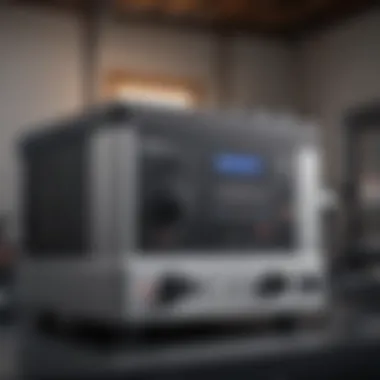Electrolysis Practices and Insights in Columbus, GA


Intro
Electrolysis is a chemical process that employs direct electric current to drive a non-spontaneous reaction. This mechanism has various applications, including metal extraction, water splitting, and synthesis of chemicals. The relevance of electrolysis extends to both industry and research, making it an essential topic for exploration in any geographical context, including Columbus, Georgia. This section embarks on a deep dive into the practices and implications of electrolysis in this specific locale, examining its historic evolution, current trends, and future prospects.
Research Overview
Understanding the landscape of electrolysis in Columbus, GA, requires a structured methodological approach.
Methodological Approaches
A variety of research methodologies can be employed to investigate electrolysis within this region. Comparison studies tend to focus on:
- Historical data analysis to examine traditional techniques and their impact.
- Interviews with local industry experts to gather insights and firsthand experiences.
- Case studies of businesses employing electrolysis in manufacturing and commercial settings.
These approaches provide a well-rounded perspective on how electrolysis has been practiced and evolved. It also aids in identifying gaps in current knowledge that future research can address.
Significance and Implications
The importance of studying electrolysis cannot be overstated. As industries are increasingly looking for sustainable solutions, electrolysis presents less harmful alternatives to traditional methods. Insights gained from research in Columbus can potentially influence local regulations, business strategies, and educational programs, ultimately fostering technological advancement. An understanding of these implications helps to reshape how communities engage with modern scientific practices.
Current Trends in Science
Columbus is not isolated from the broader advancements in electrolysis technology.
Innovative Techniques and Tools
Recent years have seen innovations in electrolysis methods, which include:
- Development of more efficient electrolyzers that reduce energy consumption.
- Usage of renewable energy sources for powering electrolysis processes.
- Enhancement of water splitting methods to improve hydrogen production.
These advancements are critical as they promote the integration of sustainable practices within traditional sectors.
Interdisciplinary Connections
Contemporary electrolysis research often intersects with various scientific disciplines, such as chemistry, physics, and environmental science. The collaboration among researchers from different fields enhances the understanding of:
- The fundamental reactions involved in electrolysis.
- The environmental impact of utilizing electrolysis in industrial processes.
- The economic potential of hydrogen and other byproducts derived from electrolysis.
"In Columbus, the trend is towards adopting newer technologies that align with sustainability goals. Every advancement is a step towards mitigating environmental concerns."
This interconnectedness not only enriches the academic landscape but also fosters a more comprehensive approach to tackling real-world challenges.
Understanding Electrolysis
Electrolysis is a process that uses an electric current to drive a non-spontaneous chemical reaction. This section aims to understand its fundamental importance, especially in relation to its applications and implications in various fields. Grasping the concept of electrolysis is crucial for students, researchers, and professionals who seek to explore its diverse uses—ranging from industrial processes to energy solutions. The understanding of electrolysis can guide innovations and improvements in both practical and theoretical aspects.
The Fundamental Principles
The principle of electrolysis relies on the movement of ions in a solution when an electrical current is applied. When a conductive solution or molten ionic compound is subjected to an electric current, ions migrate toward the electrodes. The positive ions, or cations, move towards the cathode, while the negative ions, or anions, move towards the anode. This migration allows for significant chemical changes to occur, leading to the transformation of materials.
The main components of electrolysis are the electrolyte, anode, and cathode. The electrolyte is the medium that allows for the conduction of electricity and typically consists of salts, acids, or bases dissolved in water. The flow of current through the electrolyte leads to oxidation-reduction reactions at the electrodes. Understanding these basic principles allows researchers to manipulate the process for desired outcomes, making electrolysis a versatile tool in scientific and industrial applications.
Chemical Reactions Involved
Chemical reactions during electrolysis involve oxidation and reduction processes, often termed redox reactions. At the anode, oxidation occurs, where electrons are released from a substance. At the cathode, reduction takes place as electrons are gained by another substance.
For example, in the electrolysis of water, water molecules are broken down into hydrogen and oxygen gas. The half-reactions can be summarized as:


- At the Anode: 2H₂O → 4H⁺ + O₂ + 4e⁻
- At the Cathode: 4H⁺ + 4e⁻ → 2H₂
This reaction highlights not only the production of gases but also the necessity of balancing the charge in the solution. Recognizing these chemical processes helps further explore the potential applications of electrolysis in various fields, such as energy storage and chemical manufacturing.
Equipment and Setup
Setting up an electrolysis system involves specific equipment and careful considerations. The primary components include a power supply, electrodes, and the electrolytic solution.
- Power Supply: An appropriate power supply is essential to maintain a consistent current. Some common power sources are DC power supplies or batteries.
- Electrodes: These can be made from various conductive materials, such as graphite or platinum, based on the reaction desired. Each material can influence the effectiveness of the electrolysis process.
- Electrolytic Cell: The cell must be set up to contain the electrolyte while ensuring it is safe and efficient. The arrangement should allow for minimal energy loss during the reaction.
The setup can vary significantly based on the specific application. For experimental setups in a laboratory, controls need to be in place to monitor temperature, concentration, and other variable factors to ensure accurate results.
Understanding these elements of the electrolysis setup is important for anyone involved in related fields, as it directly affects the efficiency and outcomes of the process.
Electrolysis Applications
Electrolysis plays a pivotal role in various sectors, and its applications are multifaceted, influencing both industry and daily life. Understanding these applications is crucial not only for professionals in the field but also for those keen on the sustainability and efficiency of modern technologies. Overall, the implications of electrolysis extend beyond mere processes; they reflect advances in technology and environmental stewardship. Below, we explore several key applications.
Industrial Usage
In the industrial sphere, electrolysis is extensively used in the production of chemicals. The process allows for the extraction of elements from their ores and the synthesis of compounds. For instance, chlorine and sodium hydroxide are produced through the electrolysis of brine. This application underscores the efficiency of electrolysis in providing essential materials for various manufacturing processes.
Furthermore, electrolysis is integral in the aluminum industry. The Hall-Héroult process uses electrolysis to separate aluminum from its ores, primarily bauxite. The method results in purified aluminum capable of further use in construction, automotive and aerospace industries. The industrial reliance on electrolysis demonstrates its importance in sustaining economic activities.
Water Purification
Electrolysis also finds application in water treatment. This method helps in purifying water by breaking down contaminants using electric current. When applied to wastewater treatment, electrolysis can lead to the breakdown of complex organic compounds that are otherwise difficult to eliminate. Additionally, it can assist in disinfection, rendering water safe for human consumption.
The use of electrolysis in water purification contributes to improved public health and environmental conservation. As global water scarcity becomes a critical issue, adopting such technologies could alleviate some challenges associated with providing clean water to communities.
Metal Refining
Electrolysis is a common practice in metal refining, allowing for the recovery of metals from ores and recycled materials. Copper refining is a notable example where electrolysis helps produce pure copper from impure sources. This process not only enhances quality but also provides a way to reuse materials, promoting circular economy principles.
The efficiency of electrolysis in metal refining reduces the need for mining new sources, aligning with sustainable practices. In this regard, the role of electrolysis extends into resource management, marking a significant advancement in industrial methodologies.
Electrolysis in Medicine
In the medical field, electrolysis serves several purposes, particularly in diagnostics and therapeutic applications. The technique can help in cellular manipulation, which is beneficial for research and medical treatments. For instance, certain electrolysis methods can assist in drug delivery by employing electric fields to enhance the permeability of cell membranes.
Additionally, procedures like electrolysis hair removal are popular in cosmetic applications. The process uses electrical currents to eliminate hair follicles, highlighting a practical and non-invasive application of the technology in health and cosmetics. This diverse range of medical applications highlights the ongoing innovation spurred by electrolysis.
Energy Storage Solutions
Electrolysis contributes significantly to energy storage, particularly in the context of hydrogen production. By using excess renewable energy, water can be split into hydrogen and oxygen through electrolysis. This hydrogen can then be stored and used as a clean fuel source, reducing reliance on fossil fuels.
The development of efficient electrolysis techniques is essential to advancing hydrogen economy, which promises to provide a sustainable energy solution.
Local Context: Electrolysis in Columbus, GA
Electrolysis plays a significant role in both the scientific and industrial spheres, and understanding its local context in Columbus, Georgia, can unveil crucial insights for students, researchers, and professionals alike. The relevance of electrolysis in this area arises from its applications in industries such as manufacturing, energy, and healthcare. It is essential to examine how local practices evolve with advancements in technology and regulatory developments. The unique characteristics of Columbus, including its historical background and economic framework, further shape the electrolysis landscape here, making this inquiry worthwhile.
Historical Overview
The rich history of electrolysis in Columbus can be traced back to the city's development in the late 19th century. Early pioneers in science and engineering in Columbus contributed to the understanding of electrochemical processes, setting the stage for future advancements. The industry witnessed significant growth during the mid-20th century, bolstered by local universities and research institutions that focused on practical applications of electrolysis.
Over the decades, Columbus has become a hub for innovation. While the initial applications predominantly catered to metal refining and wastewater treatment, diverse industries now leverage electrolysis for producing clean energy and various chemical processes. The historical significance of electrolysis practices in Columbus reflects the city's adaptability and ongoing commitment to embrace modern technologies.


Current Industry Landscape
Presently, the industrial landscape in Columbus is marked by a blend of established companies and emerging startups that utilize electrolysis in innovative ways. Local manufacturers increasingly rely on electrolysis for processes like water purification and metal extraction. As sustainability becomes a primary concern, businesses are exploring more eco-friendly practices, often integrating electrolysis to reduce environmental impacts.
Moreover, the collaboration between local firms and educational institutions fosters a robust environment for research and development. This synergy not only enhances industrial practices but also encourages the cultivation of future experts in the field. Economic development initiatives by local government further support industries adopting electrolysis, highlighting its potential for job creation and technological advancement.
Key Players in Columbus
Several key players define the electrolysis landscape in Columbus. Notable among them is the Columbus Water Works, which has implemented electrolysis for efficient wastewater treatment solutions. Similarly, companies like Fort Benning and other nearby military installations utilize electrolysis to maintain water purity and uphold operational standards.
In the manufacturing sector, industries such as automotive and aerospace utilize electrolysis for specific applications, contributing to the region's economic resilience. Research institutions, including Columbus State University, engage in ongoing studies that capitalize on local strengths to enhance the understanding and applications of electrolysis.
Innovations and Research Institutions
Research and innovation are pivotal in shaping the future of electrolysis in Columbus. Local institutions, such as the Institute for Advanced Manufacturing at Columbus Technical College, focus on practical training and exploration of cutting-edge electrolysis techniques. These initiatives promote hands-on learning and industry collaboration, ensuring that students and professionals remain at the forefront of technological advancements.
Also notable is the collaborative research conducted with Georgia Tech, which investigates novel materials and processes to improve electrolysis efficiency. The goal is to not only enhance performance but to address sustainability challenges through cleaner and more effective methodologies.
In summary, the local context of electrolysis in Columbus, GA, is characterized by historical significance, a robust current industry landscape, proactive key players, and continuous innovation. This comprehensive understanding lays a strong foundation for future discussions surrounding regulations, challenges, and opportunities.
Regulatory and Environmental Considerations
Understanding the regulatory and environmental considerations surrounding electrolysis is terrifically important for anyone involved in this field. These factors not only influence operational practices but also affect innovation and adoption of technologies in Columbus, GA. Awareness of regulations can help manufacturers, researchers, and policymakers create and implement effective strategies while ensuring compliance with existing laws. In addition, environmental assessments provide critical insights into the sustainability aspect of electrolysis, thereby enabling efforts to minimize ecological footprint.
Federal Regulations
Federal regulations govern various aspects of electrolysis, particularly when it comes to safety and environmental protection. The Environmental Protection Agency (EPA) establishes guidelines that deal with emissions, waste management, and water quality standards. These regulations ensure that any substances produced during the electrolysis process do not harm the environment or public health. The Clean Air Act and Clean Water Act are examples of federal laws that might influence electrolysis operations. Compliance with these acts is essential not only for environmental protection but also for companies wanting to avoid penalties or legal actions.
State-Specific Guidelines
In addition to federal regulations, state organizations also impose specific guidelines that impact how electrolysis is practiced. In Georgia, the Department of Natural Resources and the Environmental Protection Division outline detailed requirements for air quality and waste disposal related to industrial practices, including electrolysis. These state-specific regulations may differ from federal laws, thus requiring local companies to adapt their processes accordingly. Understanding these directives is crucial, as they can dictate operational procedures and permit acquisitions while ensuring local environmental standards are met.
Environmental Impact Assessment
Environmental impact assessments (EIAs) play a vital role in evaluating the potential effects of electrolysis operations on the environment. These assessments are conducted to identify risks and propose mitigation measures. A comprehensive EIA assesses various factors, including resource usage, waste generation, and effects on local ecosystems. In Columbus, GA, robust environmental assessments can facilitate sustainable practices and enhance the public perception of electrolysis initiatives. Subsequently, this can improve community support and promote long-term viability of projects. Communities benefit when companies prioritize environmental responsibility and show commitment to sustainable practices.
"The intersection of regulation and environmental concerns shapes not just compliance but innovation in the field of electrolysis, ensuring practices evolve alongside societal expectations."
In summary, regulatory and environmental considerations are foundational to the practice of electrolysis in Columbus, GA. By understanding both federal and state regulations, professionals can navigate the challenging landscape of compliance. Moreover, the importance of environmental impact assessments cannot be understated, as they guide sustainable operations. Moreover, these aspects ensure a balance between economic advancement enabled by electrolysis and the health of the environment.
Challenges and Opportunities
The landscape of electrolysis presents both challenges and opportunities for development in Columbus, GA. Understanding these aspects can help stakeholders navigate potential pitfalls while leveraging the benefits available within the field. Addressing technical barriers, navigating market dynamics, and pursuing sustainability initiatives are key elements that can shape the future of electrolysis practices.
Technical Barriers
Technical barriers refer to the obstacles that impede progress and innovation in electrolysis technology. One prominent challenge is the efficiency of the process itself. Current systems often face energy loss, which can make operations costly. Researchers are constantly working to develop more efficient electrodes and electrolytes; however, implementing these advancements on a commercial scale can be difficult.
- Another issue is scalability. Small-scale electrolysis setups may yield successful results, but scaling these to larger systems introduces complexities in design and operation.
- Reliability of equipment is another aspect that must be considered. Aging infrastructure can lead to maintenance challenges, which impact productivity.
Overcoming these technical barriers requires collaborative efforts among researchers, engineers, and industry leaders to share knowledge and resources. This synergy is essential for fostering innovation and enhancing operational efficiency in electrolysis.
Market Dynamics
Market dynamics in the electrolysis sector are influenced by several factors, including supply and demand, competition, and regulatory frameworks. The demand for hydrogen production, for example, is on the rise due to the shift towards renewable energy sources.
- The emergence of hydrogen as a clean fuel presents new market opportunities, prompting investment in electrolysis technology.
- Additionally, competition among companies can spur innovation, driving prices down and making electrolysis more accessible to smaller businesses.


However, the market is not without its challenges. Fluctuating energy prices and supply chain issues can pose risks to profitability. Staying adaptable and responsive to market changes is crucial for entities operating in this space.
Sustainability Initiatives
Sustainability is a driving force in shaping the future of electrolysis. As environmental concerns become more pressing, stakeholders must prioritize sustainable practices within their operations. This includes focusing on the following:
- Renewable Energy Sources: Utilizing wind, solar, or hydro power to drive electrolysis can drastically reduce carbon footprints. This transition is critical for aligning with global sustainability goals.
- Waste Management Practices: Effective waste disposal and recycling of by-products from electrolysis processes can limit environmental impacts. Establishing programs that focus on minimizing waste will enhance the overall sustainability of operations.
By embracing sustainability initiatives, businesses can not only improve their ecological impact but also enhance their marketability among eco-conscious consumers and investors.
"Innovations in sustainability can become a competitive advantage, setting leading companies apart in the electrolysis market."
Future Directions of Electrolysis
Electrolysis stands at a pivotal moment where science and technology converge, signaling a range of future directions that can reshape industrial applications. Understanding these directions is crucial as they impact efficiency, cost-effectiveness, and sustainability within various sectors. Innovations in electrolysis can transform how we approach resource management, energy production, and waste treatment. Given its versatility, advancing the field of electrolysis will have significant repercussions not just locally in Columbus, GA, but also globally.
Emerging Technologies
Emerging technologies in electrolysis are primarily focused on enhancing efficiency and reducing energy input. Researchers are developing new electrode materials, such as transition metal oxides, that offer improved catalytic activity. Additionally, advancements are being made in membrane technology, which separates products and allows for better recovery rates of hydrogen and other elements involved in electrolysis.
Some promising technologies to consider include:
- Anion Exchange Membranes (AEM): These membranes hold the potential to simplify the electrolysis process by allowing a wider range of ionic conductors, thus making systems cheaper.
- Photoelectrolysis: This method integrates solar energy to drive the electrolysis process. It can significantly reduce energy costs, making hydrogen production via water splitting more sustainable.
- Microbial Electrolysis Cells (MEC): MECs utilize bacteria to break down organic matter, producing electricity and hydrogen in an integrated process that promotes waste reduction.
These innovations not only promise to make electrolysis more efficient but also contribute to a more sustainable energy landscape.
Research Trends
Research trends in electrolysis are geared towards addressing the challenges of scalability and economic feasibility. Studies are increasingly focusing on the optimization of operational parameters to maximize output. For instance, researchers are exploring the influence of temperature, pressure, and ionic strength on electrolysis efficiency.
Moreover, interdisciplinary approaches are becoming more common, combining insights from chemistry, engineering, and environmental science. Researchers are examining the life cycle assessment of electrolysis systems to better understand their long-term sustainability impacts. Topics worth noting include:
- The impact of alternative energy sources on the efficiency of electrolysis.
- The role of smart technologies in managing energy consumption during the electrolysis process.
- Assessing the environmental implications of large-scale electrolysis plants.
By concentrating on these areas, research is poised to significantly elevate the efficacy of electrolysis technology.
Global Perspectives
The importance of global perspectives in electrolysis cannot be overstated as different regions are pursuing unique avenues to integrate this technology. In Europe, for example, there is a heavy emphasis on renewable hydrogen, evidenced by various government-backed projects aimed at achieving carbon neutrality. Collaborations between industry and academia are fostering innovation across borders.
In Asia, countries like Japan and South Korea are investing significantly in hydrogen infrastructure. Their focus on mainstreaming hydrogen as a fuel source showcases a commitment to reducing reliance on fossil fuels.
Some highlights of global initiatives include:
- Japan's Hydrogen Roadmap: A framework aimed at promoting hydrogen production, infrastructure, and consumption.
- European Green Deal: A commitment to reduce greenhouse gas emissions through extensive use of electrolysis and hydrogen technologies.
- U.S. Federal Hydrogen Plan: A strategic approach to boost domestic hydrogen production via electrolysis as part of broader climate change initiatives.
Through these international efforts, electrolysis is becoming a key player in the global transition towards clean energy and sustainability.
Culmination
The examination of electrolysis within the context of Columbus, GA reveals several pivotal elements that contribute to its scientific and industrial relevance. Understanding electrolysis not only provides insights into the fundamental processes driving various applications but also underlines the importance of local practices. In this article, we have highlighted the significance of electrolysis in transformative applications across industries, and how it intersects with regulatory frameworks and local ecosystems.
Summary of Key Points
- Essential Principles: The fundamental principles of electrolysis are crucial for grasping its scientific callbacks and applications. Understanding these underpinnings allows stakeholders to assess its efficacy in real-world applications.
- Diverse Applications: Electrolysis has varied applications ranging from water purification to energy storage and metal refining. Each of these areas benefits differently, highlighting the versatility of this process.
- Local Context: The historical context and current landscape of electrolysis in Columbus, GA provide unique insights into how local industries leverage this technology. This includes considering key players and innovations that shape the regional market.
- Regulatory Framework: Attention to regulatory and environmental considerations ensures that practices related to electrolysis minimize negative impacts while complying with federal and state guidelines.
- Future Directions: Emerging technologies and research trends indicate a strong potential for advancement in electrolysis methods. Stakeholders should remain informed about these developments to harness the full potential of electrolysis in future applications.
Recommendations for Further Study
To further enrich the understanding of electrolysis and its implications, the following areas are recommended for additional research:
- Technological Innovations: Keep abreast of cutting-edge technologies in the electrolysis field. Understanding advancements can offer insights into more efficient and sustainable practices.
- Comparative Analysis: Conduct studies comparing electrolysis practices in Columbus with those in other regions to identify successful strategies and areas for improvement.
- Longitudinal Studies: Engage in longitudinal research to track the impacts of regulatory changes on the electrolysis industry. This can provide valuable data on how such shifts influence operational practices.
- Public Perception: Investigate public awareness and perception of electrolysis and its benefits to understand how education can shape future adoption.
- Interdisciplinary Approaches: Explore the intersection of electrolysis with fields such as environmental science and chemical engineering to foster innovative solutions that address complex challenges.
Electrolysis stands as a vital process in modern science and industry. Its multifaceted applications and the continuous evolution of technology only enhance its importance in the operational strategies of local enterprises in Columbus, GA.



